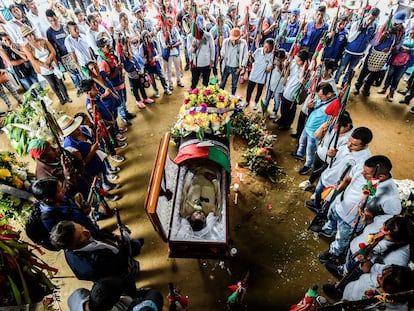The Amazon rainforest under Bolsonaro: a story of fire and violence in Brazil
Indigenous populations and riverside dwellers endure a routine of threats, forest fires and encroachment on protected land in the state of Rondônia, which has become a key battleground of the president’s environmentally damaging policies in the north of the country
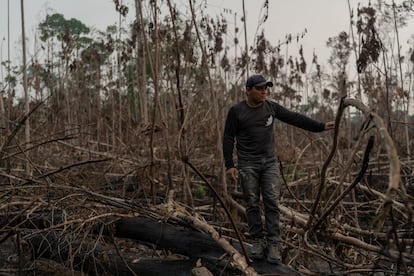

“First they take the valuable trunks and then they set fire to the forest once or twice, to turn it into pasture land,” says Daniel Kaxinawá with resignation, describing the routine of gradual destruction of the Amazon rainforest on indigenous land belonging to the Karipuna community. The 27-year-old is standing on waste ground where are a few months ago centuries-old trees stood, now replaced by charred trunks. The area where the Karipuna live covers 153,000 hectares in the municipalities of Porto Velho and Nova Mamoré in the northwestern state of Rondônia and should be protected land under a 1998 demarcation agreement, but instead it is under siege from loggers and grileiros (people who steal public land). From the ashes of the remains of the forest, green shoots are already emerging from seeds planted there by the invaders to feed their livestock.
In an area marked by the indiscriminate advance of illegal loggers, being able to tell the difference between a chainsaw and a motorcycle can be decisive for survival. Listening attentively, Kaxinawá suddenly looks worried. “There’s a bike coming in on the track behind us. Let’s get out of here now!” he says to his relatives. There is no argument and they all disappear quickly down a narrow dirt trail that leads to the only village on indigenous land.
Kaxinawá's fear – and that of all indigenous people – of coming across armed thieves or land-grabbers on their territory is not unfounded. Two days before EL PAÍS visited the area, at the end of August, the only bridge that provides access to the Karipuna’s land had been destroyed with chainsaws. “The trunks were still okay,” says Eric Karipuna, 24, pointing to the cuts in one of the thick logs that forms the passageway over a stream. “It was retaliation by the loggers,” he explains. Shortly beforehand, an inspection team from the National Indian Foundation (Funai) had expelled six non-indigenous intruders who had been setting fires in the same area the Karipuna had fled from moments earlier. Without the bridge, they were cut off. “Now the medical teams have no way of getting here,” says Karipuna, in the village where 60 members of the community live.
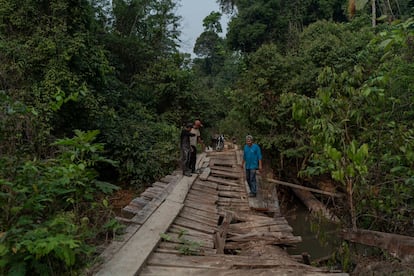
The largest swath of Karipuna territory is in Porto Velho, Brazil’s forest fire capital. Between January and August of this year there were more fires in the municipality than anywhere else in the entire Amazonian biome. During that period, the National Institute for Space Research (INPE) identified 521 separate points where the horizon was shrouded in thick smoke. A new front line of Brazilian agriculture is being established here. The state of Rondônia almost tripled its head of livestock between 1999 and 2019, from 5.4 million to 14.3 million, the sixth-largest overall in the country.
Out-of-control wildfires and increased devastation of the Amazon rainforest are the principal hallmarks of President Jair Bolsonaro’s government in the environmental sphere. In 2020, deforestation reached its highest levels of the past 12 years. In 2019, the impact of the ravaging of the Amazon was felt as far away as São Paulo, where smoke from the fires turned day into night. This year, the federal government has announced it will slash 240 million reais ($45.7 million) from the Ministry of Environment’s budget. The Brazilian Institute of the Environment and Renewable Natural Resources (Ibama) will lose $3.6 million, further weakening its ability to carry out inspections.
Rondônia is one of the most important Brazilian states for Bolsonaro’s environmental project, whose chief aim is to remove protection from lands protected by law and incentivize mining, agroindustry and logging exploitation. In 2019, former environment minister Ricardo Salles paid a visit to loggers in the area after they had torched an Ibama vehicle in protest against the institute’s inspection measures. Salles took stock of the situation and said, in clear reference to the environmental invaders who had willfully destroyed public property: “You are all representative of the good working people of this country.”
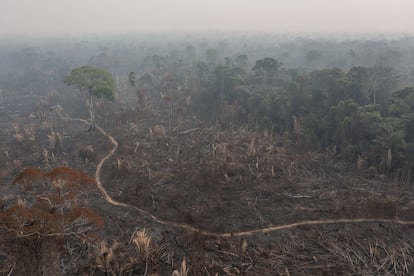
Conscious of the strategic importance of Rondônia, Bolsonaro and his family are frequent visitors. In May, the president personally inaugurated a bridge that connects Rondônia with the neighboring state of Acre. During the event, he criticized lang-grabs, but fell short of condemning those carried out by grileiros that are of such concern to the Karipuna. Instead, he targeted social movements: “There is no place here for terrorist groups. We have the means to put them in their place and make them respect the law.”
Bolsonaro’s words and deeds have fueled the audacity of illegal enterprise. “The whole process of invading our territory, burning the land and stealing trees has increased greatly under Bolsonaro’s government, due to his rhetoric. It has emboldened these people [grileiros and loggers]. They feel they can now destroy more,” says indigenous chief André Karipuna, the 28-year-old leader of his people. “And they have undermined institutions, such as Funai and Ibama, which are vital for us above all in terms of inspections.” As if the pressures created by forest fires and environmental invaders were not enough, the Karipuna territory borders the Jaci Paraná Extractive Reserve, where the highest number of fires has been recorded this year and whose overall situation is likely to worsen over the coming months.
Porto Velho’s environmental condition began to drastically deteriorate at the turn of the century. The most critical moment was the construction of two hydroelectric power plants. “There was a vigorous process of speculation over the lands of the region and many people and businesses saw it as an opportunity,” says Marcelo Lucian Ferronato of the Rondônia-based NGO Ecoporé. Two additional factors contributed to the advance of fire-setting and logging in the rainforest: “We had the expansion of the grain ports on the Madeira River and the paving of the highway to the Pacific, which turned Porto Velho into a logistics distribution center. This created a perfect storm for agroindustry. Soybean crops were pushed into grazing areas and pastures then invaded conservation areas like the Jaci Paraná reserve.”
The Jaci Paraná Extractive Reserve was delimited as a protected area in 1996 so that communities who live along the banks of the river could subsist through sustainable, centuries-old practices including harvesting rubber trees, small-scale fishing and gathering nuts. But the grileiros and loggers swiftly moved in to fell the ancient trees and turn the land into grazing pasture. The state government of Rondônia estimates there are now 120,000 head of livestock inside the reserve.
In April, the already under-siege reserve suffered another blow: the Rondônia legislative assembly passed a bill that reduced its total size by 80%, effectively rewarding the hundreds of environmental criminals responsible for turning it into the second-most deforested conservation area in the entire Amazon rainforest. The state governor, Bolsonaro supporter Colonel Marcos Rocha, ratified the measure in May. “With the reduction of the reserve, which had already been invaded and destroyed, our situation will only get worse. It served as a kind of barrier between the devastation and our lands,” says André Karipuna, who adds that the authorities paid no attention to indigenous concerns during discussions over the reduction of the protected area. State representative Jean Oliveira, who was the chief rapporteur of the bill to slash the size of the reserve, did not respond to EL PAÍS’ request for comment.
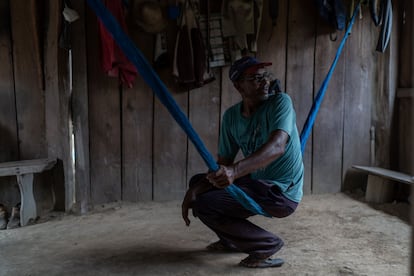
Inside the now-diminished Jaci Paraná reserve, the situation has become precarious. Rosa Maria Lopes, 66, was born and raised on the banks of the Branco River. “I was a rubber-tapper, I gathered nuts, fished and did everything my father did,” she says. “Before, there were only families who looked after the forest in a sustainable way here,” she recalls. Then, in the early 2000s, the loggers and ranchers arrived and everything changed. “Many people were evicted and many left in fear of their lives.” She estimates there are only seven families left now. “The reserve is finished. It brings tears to my eyes.”
While she speaks, Lopes watches the smoke from a fire ravaging the jungle less than a mile from the house of her neighbor and friend, João Gomes de Sousa, who also lives inside the reserve’s boundaries. “Joãozinho, you have to be careful or the wind will blow the fire to your place,” she says in reference to a simple wood construction with no electricity or running water. “Yes, it’s getting closer,” De Sousa agrees, standing alongside her. “It’s been burning for more than a week.” De Sousa earns 600 reais ($115) a month selling what he produces on his small plot in the city. “It’s those people [that set fires] to create grazing for livestock,” he says. “These fires threaten everything I have, my small bit of land and my home.” Who is responsible for the fire? João doesn’t want to speculate. “These issues create a lot of problems. You have to understand that here in the reserve there are the big people and the small people.”
Rosa Maria Lopes remembers the first time she saw the level of violence involved in the robbery of land and deforestation. It was in the 2000s, when she came across the body of a rubber-tapper who had become involved in a fight with the loggers, floating in the river. She too has been the subject of veiled threats. “Some people were hiding in the thicket near my place to frighten me. I thought about going to the police but I was scared. It’s better not to get involved with these people.” Near her home, more destruction has taken place. They’ve cut down 50 bushels from the forest near here. There isn’t even a tree left to fix up my hut.”
The former rubber-tapper is worried about Bolsonaro’s environmental policies, infamous for leaving protected land open to exploitation. “Look, the president says he will be tolerant towards everything. I don’t think that’s true. There’s no talk of planting corn or pumpkins. It’s all just agroindustry, they only talk about livestock, milk and ranches. In a few years’ time we won’t be able to scratch a living from this land,” she says.

Tales of fire and violence are a constant in conversations between residents on the reserve. “Last year I nearly died trying to put out a fire that had nearly reached a neighbor’s hut,” says Casemiro José Lopes, who has lived in the area for 20 years. After fighting the flames that were threatening his friend’s flour mill with nothing but buckets of water, the 53-year-old was hospitalized with a respiratory infection. “We don’t know who is in charge of burning the land,” he says. “What we do know is that it’s the same story every year.”
Three years ago, a group of grileiros tried to intimidate Casemiro by burning a hut set to the rear of his small property. “It happened just after we had surprised a tractor pulling down trees inside the reserve and confronted them,” he says. The sense of impotence among the community is palpable. “The reality is that we can only look after what is here on the banks of the river. In the interior [of the reserve] there is nothing we can do. I am optimistic because at least I know things can’t be any worse than they are now. There is hardly any forest left to cut down.”
As well as the fire that threatened to burn João’s home down, EL PAÍS also witnessed another huge blaze inside the reserve that torched an area of several square kilometers of dense forest canopy. A column of smoke rose on the horizon. The forest that was burned was just behind a zone that had recently been abandoned after being used by grileiros for grazing.
While agroindustry, the grileiros and the loggers continue their advance across protected zones, Chief Karipuna points to the importance of these lands. “We have to understand the jungle as something that not only holds importance for us, as its guardians, but also for the climate, for water and for humanity,” says the young leader, one of a new generation of a people that were nearly wiped out by diseases imported into the forests in the 1970s after first contact was made with the outside world.
Only seven individuals remained, who endured and managed to safeguard their heritage over the decades that followed only to face fresh adversity. In 2019, an advance post set up by Funai inside the Karipuna territory to protect the area from encroachers was burned down in a reprisal against inspections. It remains in the same state today, some abandoned ruins that symbolize the determination of agroindustry and the loggers to take possession of lands belonging to the indigenous protectors of the forest. “They say there is too much land for so few indigenous people. But in reality, we are too few indigenous people to protect this great natural resource,” says Karipuna. “And it’s curious that they never say ‘that’s too much land for just one farmer,’ isn’t it?”
The Brazilian Institute of the Environment and Renewable Natural Resources says that it has 17 inspectors currently working in Rondônia and that, in 2021, “inspections in the state have already led to 100 seizures, 75 embargoes, four destruction orders and 383 violation orders that have resulted in 63,256,449 reais ($12 million) in fines.” Ibama also says it has been working in cooperation with Funai, which declined to comment for this report.
Meanwhile, the Brazilian government stated that “the State Secretariat of Environmental Development, together with its partners, has been working in fire prevention efforts and firefighting actions throughout Rondônia State.” The communique adds that in the first half of 2021 “146 operations were carried out with the aim of combating forest fires and deforestation,” and that 1,744 fines had been levied. Judging by the evidence on the ground, these were innocuous inspections on the part of a government that incentivizes those who destroy what it claims to be trying to protect.
English version by Rob Train.
More information

